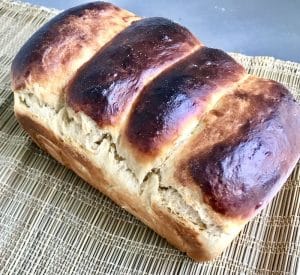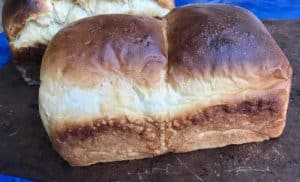For a light fluffy bread, Tangzhong and Yudane really work
Japanese Milk bread is a light fluffy bread. One of those breads that once you start eating you just don’t want to stop. You could almost call it addictive. Unfortunately ‘white fluffy bread’ may make you think of industrial loaves from K**mill or similar. There is no comparison, this bread is truly delicious. Once you’ve got your head round cooking some of the flour, it’s easy and worth trying.
Japanese Milk bread is sometimes called Shokupan (which translates as everyday bread) or Hokkaido bread. It’s an every day bread, great for toast or in a sandwich.
According to Annie Sheng an anthropologist studying Asian bread at Cornell University, milk bread might have been invented by British baker Robert Clarke, who opened Yokohama Bakery in Japan back in 1862. But it is more likely that its origins are in China.
Yudane or Tangzhong?
Time to make bread using both methods at the same time and decide your favourite. Once you’ve mastered this easy technique, you can use it in many other bread recipes.
I first came across the Tangzhong method when I was developing some cinnamon buns for a client who wanted a particularly soft crumb. I then discovered the Yudane method. Both methods use a portion of flour is cooked either with water or milk and then added to the remainder of the dough ingredients. I used as my starting points recipes from King Arthur Flour and Chopstick Chronicles.

Both Yudane and Tangzhong methods trap liquid in the cooked flour (sometimes called pre-gelatinization) which helps keep the dough soft as the cooked mixture will absorb twice as much liquid as the water you’d usually use in a dough.
The level of hydration in a Japanese Bread should be about 70% which is higher than most standard sweet dough recipes. You use some of that liquid and some of the total amount of flour to make the yudane or tangzhong. (PJ Hamel’s article will help you convert an existing recipe to the tangzhong method).
Flavour
Both loaves are delicious. The Tangzhong method is more like a brioche, the Yudane method a little lighter. Whilst you have to plan ahead a little for the Udane loaf, it has fewer ingredients and has a lovely flavour.
The breads are ideal for sandwiches and will keep fresh for a couple of days. They freeze very well too!
Get prepared
You will need scales, a digital thermometer to check when the bread has been sufficiently kneaded, a high sided bread tin or pullman tin (which has a lid) and for the Yudane method, patience! If you have a stand mixer such as a Kenwood, it will be SO much easier.

Japanese Milk Bread with Tangzhong
This is the quickest one to prepare. Just wait until the Tangzhong is cool. It’s very similar to making a roux for a sauce.


Japanese Milk Bread with Tangzhong
Equipment
- Stand mixer
- High sided bread tin (2lb / 1 kilo)
- Digital scales
Ingredients
- Tangzhong
- 50 millilitres water
- 50 millilitres milk
- 20 millilitres flour
- Dough
- 300 grams white bread flour
- 15 grams dried milk powder
- 125 millilitres water Temperature should be about 22°C
- 50 grams sugar
- 1 egg approx 50 ml
- 50 grams unsalted butter
- 5 grams salt
- 10 grams instant yeast 15 gr fresh yeast
Instructions
- Tangzhong
- Put 20 gr flour in a saucepan. Mix in 50 ml water and 50 ml milk gradually using a whisk.
- Cook the mixture on a low setting until it thickens, mixing all the time.

- Set aside and let it cool.
- The Dough
- If you are using a stand mixer: Place the bread flour, milk powder, sugar and yeast in the bowl and mix a little. Add the water and eggs and all of the Tangzhong starter. Knead on the lowest speed for 5 minutes. Add the butter little by little. Mix on a medium speed until the dough comes away from the sides and dough temperature measures between 24° and 26°C (75 to 78°F). This can take a good 10 minutes.

- If you are mixing by hand. Place the bread flour, milk power, sugar and yeast in the bowl. Rub in the butter. Add the Tangzhong starter. Add the salt and mix. Add the water and eggs. Knead until very smooth (about 10 minutes). It should be smooth and supple and measure between 24° and 26°C (75 to 78°F)
- Cover and allow to prove for about 1 hour. It should be well rise and if prodded with a finger the hole should refill slowly.
- Cut into four equal pieces. Roll into balls and leave for 10 minutes.

- Roll out each piece to about 20 cm by 16 cm.

- Fold the top third towards the centre. Fold up the bottom third to the centre. Turn 90 degrees and roll the thinner edge up very tightly.

- Place all four rolls next to each other in the bread tin. Brush with beaten egg. Allow to prove for 45 minutes to an hour. The bread will be will risen.

- Pre-heat your oven to 180°C/350°F 30 minutes before the bread is ready to bake.
- Brush with egg a second time and bake for about 30 minutes until a dark gold. Test to see whether it is done as you would a cake. Insert a knife into the centre, it should come out clean. Allow to cool in tin. It does colour quickly so cover with baking parchment if necessary.

- You can of course use this mixture to make rolls. Divide the dough into 90 gr pieces. Shape into balls. Then allow to prove as above. The rolls will need about 15 minutes to bake.

Japanese Milk Bread with Yudane
This is the recipe with Yudane. Here you leave the pre cooked flour overnight so you need to plan ahead, but it has far fewer ingredients than the Tangzhong version


Japanese Milk Bread with Yudane
Equipment
- A bread tin that will hold 1 litre of liquid. Often labelled as a 2lb loaf tin
- Optional use of a stand mixer
Ingredients
- Yudane
- 50 grams bread flour
- 40 millilitres water
- Bread
- 170 millilitres milk whole milk or semi skimmed
- 15 grams sugar
- 5 grams instant dried yeast or 10 gr fresh yeast
- 20 grams butter salted or unsalted
- 250 grams white bread flour
- 5 grams salt
- 1 egg for glazing the bread optional
Instructions
- Make the Yudane at least 8 hours you want to use it. Put 50 gr bread flour into a saucepan add 40 ml water. Mix over a low heat until very thick (a couple of minutes). Let it cool. Put into a bowl, cover it and put in the fridge overnight.

- Measure the bread flour, sugar, butter and yeast into the bowl of your stand mixer. Mix lightly then add the salt.
- Add the milk and mix to combine all the ingredients. Then start mixing dough at a medium speed. Add the yudane torn into small piece into the dough. Knead until the dough comes away from the sides of the bowl (at least 10 minutes). It should measure between 24° and 26°C (75 to 78°F).
- Cover the bowl and allow to prove for about 1 hour. It will rise well in this time. When pressed with a finger, the whole made will fill very slowly.

- Cut the dough into two equal pieces and shape into balls. Let it rest for 10 minutes.
- Roll out each pieces to about 15 x 20 cm with a rolling pin. Roll each piece up tightly, then roll a second time from the thinner end.

- Place both pieces of dough next to each other in the tin.

- Pre-heat your oven to 180°C/350°F
- Cover the breads with a damp tea towel and allow to rise for 30 minutes. It should fill the tin. Brush with egg before baking.
- Bake the bread for 25 to 30 minutes. Test to see whether it is done as you would a cake. Insert a knife into the centre, it should come out clean. It does brown easily so cover with baking parchment if it is browning very quickly.

Discover my series of Bake Better Bread tips












It’s my interpretation of the original recipe, I find it easier to cook rather than just pour over boiling water. Either method will work!
Your yudane recipe did not mention mixing the flour with boiling hot water but instead mentioned “mixing over a low heat”?
Well spotted Mary I’ve updated the recipe. Thank you!
Apologies if I’m not reading this correctly, but where do you add the Tangzhong to the Dough in the first recipe?
You are right Trish and that’s what’s in the recipe.
I thought Yudane method used flour and boiling hot water mixed together and rested overnight in the refrig brought to room temp the following day while tangzhong method flour and water is cooked in the sauce pan , cooled and could be used right away.
Thank you Johannes. So pleased it worked for you! You can use the techniques for other breads too.
The water/milk roux really does the magic…